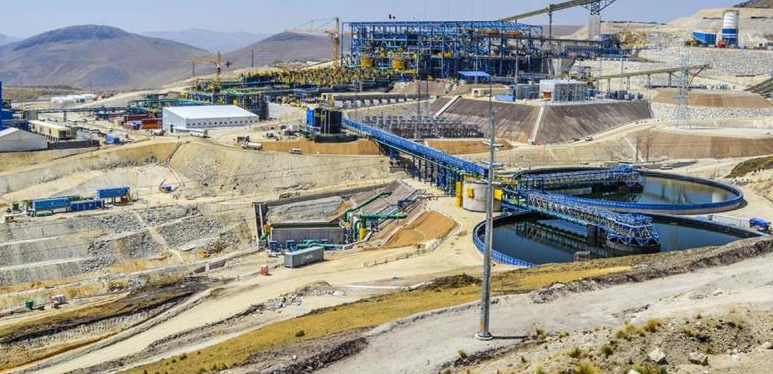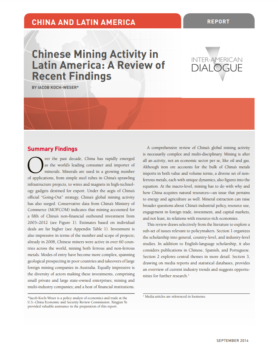The Politics Of Disaster Relief
After a 7.0 magnitude earthquake struck Haiti, the aftershock reached China in ways that few anticipated.The earthquake forced Chinese leaders to navigate the tricky politics of disaster relief.
A Daily Publication of The Dialogue
Copper production at Peru’s Las Bambas mine, which is owned by Chinese state-controlled company MMG, restarted in early July following a two-month shutdown amid protests by Indigenous groups. During the shutdown, mining executives and analysts met in Lima to discuss concerns about social protests taking a toll on investment in the mining sector. How much do protests threaten investment from China and elsewhere in the mining sectors of Peru and other South American countries? What are the main demands of protesters in the vicinity of mines, and how should mine owners seek to work with them? What should the governments of Peru and other countries in South America do to help mines and local communities co-exist?
Sergio Bitar, nonresident senior fellow at the Inter-American Dialogue and former Chilean minister of mining, education and public works: “The case of the Las Bambas mining company deserves special attention in all copper-producing countries, as it helps to anticipate future conflicts. For a decade, the reality has become much more complex. First, global changes will demand more and more copper in order to electrify the planet and respond to twin challenges—green and digital. Second, national changes require a response to social and environmental sustainability. Third, the awareness and power of Indigenous communities, and international pressure to protect them, have expanded. Conflicts are multiplying among citizens and the environment, communities and companies, central and local authorities, between ministries, among politicians who argue over social networks, and amid an absent state and executives who are incapable of understanding communities. A fundamental cause of the problems at La Bambas is that the mine acted unilaterally, seeking direct agreements with communities, without the participation of the state. This is a serious gap in Peru. The state must prioritize the living conditions in the communities, coordinate with mayors, establish and supervise norms and procedures, and update regulations for companies. Copper-producing countries must strengthen institutions and dialogue. This would require the creation of capacities that the weakest countries do not have and that some companies do not respect. All stakeholders must be involved, and the state in particular must improve its ability to anticipate and regulate.”
Margaret Myers, director of the Asia & Latin America Program at the Inter-American Dialogue: “Chinese companies in Peru’s mining sector have been the subject of extensive analysis over the years, as academics, journalists and other researchers have sought to understand how companies such as MMG, Chinalco and Shougang are operating and whether they differ from other international mining companies, especially as China continues to express interest in copper and other projects across the region. China’s mining companies certainly aren’t the first to encounter opposition to their operations in Latin America, but in Peru, at least, deficient communications between these companies and the communities where they are based have been problematic for many years now. This was true of Shougang’s initial operations in Marcona and now of MMG’s relations with residents of the Mara district. For MMG, relations soured when the company, citing changes in mining sector regulations, sought to transport mined copper by road instead of pipeline. Challenges aside, China’s activity in the sector is expected to continue more or less apace, even as broader China-Peru relations continue to suffer the consequences of a Covid-19 vaccine-related corruption scandal. Chinese mining companies are well-established in Peru (and increasingly elsewhere in the region), and their investments contribute substantially to Peru’s overall GDP. Of interest now is whether China’s enhanced focus on ESG, as underscored even by Xi Jinping, will affect these and other Chinese companies’ approach to community engagement and broader standards setting.”
Jiang Shixue, professor and director of Center for Latin American Studies at Shanghai University: “It is true that resistance and protests have impeded Latin America’s business climate for the foreign enterprises in its mining sector. Two issues are conspicuous here. The first one is about the relationship between mining development and protection of the environment. Some people in Latin America believe governments should or can build hospitals, schools, roads and bridges for the public as well as raise the living standards of the people without economic growth. But they do not ask where the governments can locate the money. Therefore, it is correct to say that either wing of the ‘bird,’ that is, development of the mining sector and the protection of the environment is indispensable. The second issue is related to the so-called corporate social responsibility (CSR) undertaken by the foreign enterprises. Countless examples have shown that Chinese enterprises in the mining sector of Latin America have done a very good job in its fulfillment of CSR. On the one hand, they apply advanced technologies to greatly reduce or even generate no damages at all to the environment; on the other, they allocate a lot of profits to push forward economic and social development for the local communities. Undoubtedly, the trend of attracting more foreign investment in Latin America’s mining sector is irresistible simply because the region’s economy needs to grow. Sadly, stimulated by the disinformation about Chinese investment, negative sentiment against this kind of investment is growing at a rapid pace.”
Maiah Jaskoski, professor of political science at Northern Arizona University: “Communities in Latin America’s mining zones have staged protests, turned to the courts and physically blocked mine sites in their efforts to prevent, alter and/or benefit from new extraction. This activism has stalled and even shut down mine projects. In some cases, firms and governments may avoid standoffs with local communities, and the emergence and hardening of anti-project sentiment, by hearing community concerns early on. For the state, this approach would entail creating substantive, formal participatory processes. Civil society organizations and the community at large thus would have ample time and resources to learn about project options, mine impacts and compensation plans; and, ultimately, to provide feedback to and make demands on companies and the state. Yet governments in the region commonly attempt to support and streamline mining development by installing only limited opportunities for communities to learn about and react to proposed development. These restrictive participatory institutions ultimately leave mining companies and their investments highly vulnerable to community activism. Still, it would behoove firms that are committed to project development to distribute transparently information about their mining plans to communities, working within (even limited) state-led participatory and informational processes. Companies can and do build direct relationships with communities outside of state-sanctioned participatory spaces, but this tactic can backfire: it frequently generates the perception that the firms are attempting to buy off, divide and weaken the communities and their representative organizations.”
Patricia I. Vásquez, global fellow at the Wilson Center: “There is no one-size-fits-all solution to natural resource conflicts. From opposition to lithium mining in Serbia, Chile or Nevada to the shutdown of Peru’s Las Bambas copper mine due local community protests, each conflict has its unique traits. Local communities in producing regions in Latin America have a shared history of unfulfilled expectations and false promises on the part of the authorities and/or producing companies. In recent decades, companies and governments in many cases succeeded in avoiding conflicts, mainly through improved communication techniques and transparency. But more often than not, past mistakes come back to haunt them. In some cases, conflicts may be exacerbated by a lack of state presence in a producing region, or by wrong corporate approaches to dialogue. Sometimes, organizations defending a community cause may end up exacerbating local divisions. It is important to know the local history and for all stakeholders to commit to finding a solution based on realistic goals agreed upon among all stakeholders.”
R. Kirk Sherr, president of Clearview Strategy Group, and Lawrence J. Gumbiner, senior advisor at WestExec Advisors: “A combination of high energy prices, slowing economies and leftist policy orientation have rekindled traditional natural resource equity disputes in Latin America. Even in good times, maintaining the ‘extractive consensus’ among diverse communities and interests is a tall order. Natural resource development policy is particularly relevant in the Andean countries where natural resource exports typically contribute 40 percent to 50 percent of all export earnings. In Peru, social conflict in mining zones has been longstanding but escalated during the pandemic. Community expectations were raised by the election of Pedro Castillo, who has proven incapable of living up to campaign promises to address the social inequities present in mining locales. Many of the demands—largely related to environmental concerns, housing and transport infrastructure—are legitimate. But some of the protests are led by groups who are part of a cottage industry designed to extract financial and land concessions from deep-pocketed entities. Companies now have more tools than ever at their disposal both to improve local government administration and to address local needs. Renewable energy, distributed generation and battery storage allow mining companies to support communities in many new ways including everything from water treatment, broadband, telemedicine and remote education. And many satellite services can be used for environmental monitoring. The key for governments and mining concerns is to consult extensively at the outset of the investment, giving local communities a stake in the success of the project. Anglo American’s Quellaveco mine in Peru, producing copper a mere four years after approval, is a prime example of successful company and community collaboration.”
 The Latin America Advisor features Q&A from leaders in politics, economics, and finance every business day. It is available to members of the Dialogue’s Corporate Program and others by subscription.
The Latin America Advisor features Q&A from leaders in politics, economics, and finance every business day. It is available to members of the Dialogue’s Corporate Program and others by subscription.
After a 7.0 magnitude earthquake struck Haiti, the aftershock reached China in ways that few anticipated.The earthquake forced Chinese leaders to navigate the tricky politics of disaster relief.
Despite reports in recent months that Mexican manufacturing is experiencing a resurgence, Mexico’s industrial sector faces tremendous challenges.
China has rapidly emerged as the world’s leading consumer and importer of minerals.
 Peru’s Las Bambas mine (pictured) restarted copper production last month following a two-month shutdown due to protests at the site. // File Photo: TV Perú.
Peru’s Las Bambas mine (pictured) restarted copper production last month following a two-month shutdown due to protests at the site. // File Photo: TV Perú.
